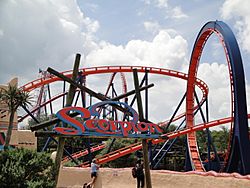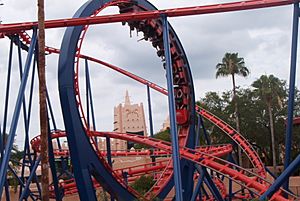Scorpion (roller coaster) facts for kids
Quick facts for kids Scorpion |
|
|---|---|

Scorpion seen within the Timbuktu section with SheiKra in the background
|
|
| Busch Gardens Tampa Bay | |
| Location | Busch Gardens Tampa Bay |
| Park section | Pantopia |
| Coordinates | 28°02′15″N 82°25′24″W / 28.03750°N 82.42333°W |
| Status | Operating |
| Opening date | May 16, 1980 |
| Cost | US$2.5 million – US$3 million |
| General statistics | |
| Type | Steel |
| Manufacturer | Anton Schwarzkopf |
| Designer | Werner Stengel |
| Model | Silver Arrow |
| Lift/launch system | Chain lift hill |
| Height | 60.7 ft (18.5 m) |
| Length | 1,817.6 ft (554.0 m) |
| Speed | 41 mph (66 km/h) |
| Inversions | 1 |
| Duration | 1:30 |
| G-force | 3.5 |
| Height restriction | 42 in (107 cm) |
| Trains | 2 trains with 5 cars. Riders are arranged 2 across in 2 rows for a total of 20 riders per train. |
| Scorpion at RCDB | |
Scorpion is a cool steel roller coaster at Busch Gardens Tampa Bay in Tampa, Florida. It was built by Anton Schwarzkopf and designed by Werner Stengel. Scorpion first opened on May 16, 1980. It was the second roller coaster ever built at the park.
Scorpion was added as part of a new area called Timbuktu. This area was surrounded by the Congo and Nairobi sections of the park. The roller coaster is 60.7 feet (18.5 m) tall and can reach a top speed of 41 miles per hour (66 km/h). Its track is 1,817.6 feet (554.0 m) long.
Scorpion is special because it's one of only three "Silver Arrow" roller coasters made by Anton Schwarzkopf. It's also the only one that stays in one place permanently. When it first opened, people really liked it. After another ride called Python closed in 2006, Scorpion became the oldest roller coaster at Busch Gardens Tampa Bay.
Contents
The History of Scorpion
In 1978, Anheuser-Busch, who owned Busch Gardens Tampa Bay, announced big plans for the park. They wanted to add a new area. This new section was named "Timbuktu." Construction for Timbuktu started in November 1978.
On February 5, 1979, Anheuser-Busch shared more details about the Timbuktu expansion. It was a 7-acre (2.8 ha) addition that would cost $12.3 million. This new area would have several fun attractions, including a roller coaster called "Scorpion." They said it would be a "European designed roller coaster with a 360-degree-loop."
The Timbuktu area opened in two parts. Scorpion was part of the second opening. It was supposed to open in December 1979, but the date was changed a few times. The Timbuktu section officially opened to visitors on January 25, 1980.
Scorpion was still being built in March 1980. Finally, on May 16, 1980, Scorpion opened its doors! It was the park's second roller coaster. In 2004, Scorpion got a fresh new look. Its track was repainted red, and its supports became blue. This is similar to the colors of another ride called SheiKra. Today, Scorpion is located in the Pantopia section of the park. This area replaced Timbuktu when the park added a new drop tower ride called Falcon's Fury.
What It's Like to Ride Scorpion
When you get on the train, it leaves the station and starts climbing. It goes up a 60.7 feet (18.5 m) lift hill. Once at the top, the train turns a little to the right. Then, it drops down fast, reaching its top speed of 41 miles per hour (66 km/h).
After the big drop, the train goes into Scorpion's most famous part: a 39.3 foot (12.0 m) vertical loop. This loop turns you completely upside down! After the loop, the train makes a banked left turn and goes up another hill.
Then, it turns left again and drops into a banked curve. It straightens out and goes up a small hill, passing right through the middle of the vertical loop again. Next, the train enters a series of turns that spiral downwards. These are called helixes.
Finally, the train straightens out and enters the final brake run. It slows down and then turns right, going around the outside of the ride. After another right turn, you arrive back at the station. One full ride on Scorpion takes about one and a half minutes.
Fun Facts About Scorpion
The Scorpion roller coaster was built by Anton Schwarzkopf and designed by Werner Stengel. Building the ride cost between $2.5 million and $3 million. Scorpion is one of three "Silver Arrow" roller coasters ever made by Schwarzkopf. The other two are Big Blue in Croatia and Looping Star in South Africa. Scorpion is special because it has a permanent structure, while the other two can be moved.
Scorpion's track is 1,817.6 feet (554.0 m) long. The entire ride fits into an area that is 93.5 foot (28.5 m) by 213.8 foot (65.2 m). Riders on Scorpion feel a maximum of 3.5 g-forces. This means you feel 3.5 times your own weight pushing on you! The roller coaster is named after the animal, the scorpion.
The ride uses two trains. Each train has five cars, and each car has two rows with two seats in each row. This means up to twenty riders can be on one train at a time. When it first opened, the trains were red and orange. Now, they are red, orange, and yellow. Riders are held in place by a lap bar. To ride Scorpion, you need to be at least 42 inches (110 cm) tall.
Images for kids



